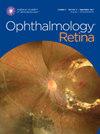Bilateral Anti-VEGF on Same-Day-Investigation on Safety in Retinopathy of Prematurity
IF 5.7
Q1 OPHTHALMOLOGY
引用次数: 0
Abstract
Purpose
To report an incidence of procedure-related complications in preterm infants with retinopathy of prematurity (ROP) treated with intravitreal anti-VEGFs injection in both eyes on the same day.
Design
Retrospective, multicenter case series.
Subjects
Preterm infants with ROP treated with anti-VEGF bilaterally on the same day.
Methods
All included infants underwent intravitreal anti-VEGF injection in both eyes under aseptic precautions in an ophthalmic operation theater (OT) or neonatal intensive care unit (NICU). A postoperative examination was performed to look for procedure-related complications.
Main Outcome Measures
Incidence of procedure-related complication (presumed endophthalmitis, intraocular inflammation, lens injury, vitreous hemorrhage, and retinal tear) in the study cohort. To study the association of indication, type of anti-VEGF, type of needle used, setting of procedure, site of injection (distance from limbus), and experience of the treating ophthalmologist with the complications.
Results
Nine thousand nine hundred and eighty-four eyes of 4992 infants were analyzed. The procedure was most commonly performed in ophthalmic OT (8258, 82.7%) using a 29G (4514, 45.2%) needle between 1 and 1.5 mm (9984, 100%) from limbus. Aggressive ROP was the most common indication for anti-VEGF use (4866, 48.7%), whereas Bevacizumab was the most commonly used anti-VEGF agent (8642, 86.6%). Overall, 26 eyes (0.3%) had procedure-related complications. Lens injury (15, 0.15%) and presumed endophthalmitis (7, 0.07%) were the most common complications. One eye had culture-proven endophthalmitis with Pseudomonas aeruginosa. No case of bilateral endophthalmitis was noted. Endophthalmitis was not associated with the setting of a procedure or type of anti-VEGF used, whereas the risk of lens injury was 7 times higher when performed in NICU and 30 times higher when performed by an ophthalmologist with <1 year of experience in injecting anti-VEGF in preterm infants.
Conclusions
The incidence of presumed endophthalmitis after bilateral same-day anti-VEGF in infants with ROP is 0.07%. These infants can be treated in both eyes on the same day with the anti-VEGFs and needles (29–32G) evaluated in this study, with emphasis on the direction of needle parallel to the visual axis. Extra precaution is advocated if the procedure is planned in the NICU or by an ophthalmologist with limited experience.
Financial Disclosure(s)
The authors have no proprietary or commercial interest in any materials discussed in this article.
同日双侧抗血管内皮生长因子--早产儿视网膜病变安全性调查(BASISROP)--一项多中心回顾性研究。
目的:报告在同一天接受双眼玻璃体内抗血管内皮生长因子(抗 VEGF)注射治疗的早产儿视网膜病变患者中,手术相关并发症的发生率:同日接受双眼抗血管内皮生长因子治疗的早产儿视网膜病变方法:干预:在眼科手术室(OT)或新生儿重症监护室(NICU)的无菌预防措施下,所有纳入的婴儿均接受了双眼玻璃体内抗血管内皮生长因子注射。术后进行检查,以发现与手术相关的并发症:研究队列中与手术相关的并发症(推测眼内炎、眼内炎、晶状体损伤、玻璃体出血、视网膜撕裂)的发生率。研究适应症、抗血管内皮生长因子类型、所用针头类型、手术环境、注射部位(距角膜缘的距离)以及主治眼科医生的经验与并发症的关联:对 4992 名婴儿的 9984 只眼睛进行了分析。最常见的手术是在眼科手术室进行(8258 例,82.7%),使用的针头为 29G(4514 例,45.2%),距离角膜缘 1-1.5 毫米(9984 例,100%)。早产儿侵袭性视网膜病变是抗血管内皮生长因子最常见的适应症(4866,48.7%),而贝伐单抗是最常用的抗血管内皮生长因子药物(8642,86.6%)。总体而言,26 只眼睛(0.3%)出现了与手术相关的并发症。最常见的并发症是晶状体损伤(15,0.15%)和推测眼内炎(7,0.07%)。有一只眼睛经培养证实患有铜绿假单胞菌眼内炎。没有发现双侧眼内炎病例。眼内炎与手术环境或使用的抗血管内皮生长因子类型无关,而在新生儿重症监护室进行手术时,晶状体损伤的风险要高出7倍,由在早产儿注射抗血管内皮生长因子方面经验不足1年的眼科医生进行手术时,晶状体损伤的风险要高出30倍:患有早产儿视网膜病变的婴儿在当天注射双侧抗血管内皮生长因子后,推测眼内炎的发生率为 0.07%。这些婴儿可在同一天使用本研究中评估的抗血管内皮生长因子和针头(29-32G)进行双眼治疗,重点是针头方向要与视轴平行。如果计划在新生儿重症监护室或由经验有限的眼科医生进行手术,则应格外小心。
本文章由计算机程序翻译,如有差异,请以英文原文为准。
求助全文
约1分钟内获得全文
求助全文

 求助内容:
求助内容: 应助结果提醒方式:
应助结果提醒方式:


